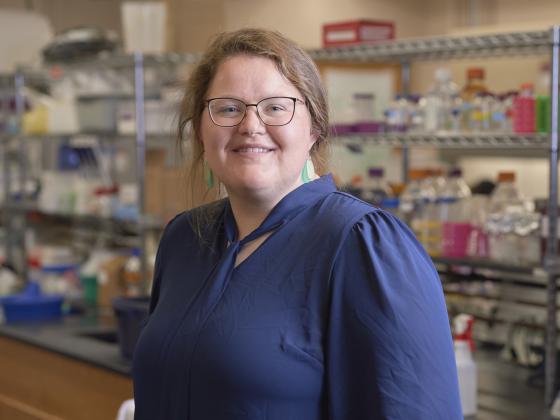BOZEMAN — A graduate student at Montana State University has been awarded a distinguished fellowship from NASA. Haley Ketteler, who is expected to graduate with a master’s degree in electrical engineering later this year, will use the Space Technology Graduate Research Fellowship to pursue her doctorate in mechanical engineering at MSU.
“Being selected as a NASA Space Technology Graduate Research Fellow is a real mark of distinction,” the space agency wrote to Ketteler. “Because of your exceptional background and potential for research, you have been chosen to develop groundbreaking, high-risk/high-payoff, early-stage space technology. Your contributions will help make science and space exploration more effective, affordable and sustainable.”
The four-year fellowship, to support Ketteler’s project “Electrochemical Impedance Sensors for Microbial Monitoring in Spacecraft Wastewater Systems,” has a maximum value of $84,000 per year that includes a stipend, health insurance, tuition and fees, and other support.
“It has been my dream to work for NASA since I was a little girl, and this is a wonderful step toward that dream,” Ketteler said. “It is also extremely encouraging to have my research interests and questions supported by established space tech developers who have a clear vision of what is needed in future space technology.”
Ketteler, who is originally from Pierre, South Dakota, is co-advised by Christine Foreman, professor of chemical and biological engineering, and Stephan Warnat, associate professor of mechanical and industrial engineering.
“This fellowship is a culmination of years of hard work on Haley’s part, and I am thrilled for her,” Foreman said. “In addition to her academic and research excellence, she is engaged with the MSU community, serving as part of the WISE leadership team and a longtime volunteer with FIRST Robotics. I am looking forward to the opportunities this will provide for Haley to more fully engage with NASA and live out her dream.”
WISE, or Women in Science and Engineering, is a student-led group that supports graduate students of all genders in science, social science, math and engineering by providing opportunities for both professional and social development.
Ketteler’s research interests include designing and building sensors to detect biofilms in spacecraft water-reclamation systems, such as on the International Space Station. Water-reclamation systems recycle and sanitize wastewater produced by astronauts and other sources. Their plumbing and machinery are fertile ecosystems for microbial life that can form biofilms — potentially harmful communities of microbes that produce a protective slime that makes them difficult to kill or remove. Ketteler is affiliated with the Center for Biofilm Engineering at MSU.
“In many future spacecraft, part of the operating procedure will be to place life-support systems into dormancy when astronauts are not on board, so we need a way to autonomously monitor the amount of biofilm in these systems to avoid system failure when emerging from dormancy. That’s where the sensors I work on will come in,” Ketteler said.
Warnat praised Ketteler’s work ethic and curiosity.
“Haley is an exceptional student, the kind you would be fortunate to have in your lab,” Warnat said. “Her diligent work ethic is matched only by her insatiable intellectual curiosity, as evidenced by her thought-provoking questions. And this is just the beginning of her journey in graduate studies.”
As part of her fellowship, Ketteler will travel to NASA’s Marshall Space Flight Center in Huntsville, Alabama, to test biofilm sensors in the model systems available at the facility .
“Depending on how the testing goes, I may continue to do annual visits to MSFC or visit other centers working on the life-support systems to explore more applications of the sensors and the research being done at the different NASA facilities,” she said.
By:




